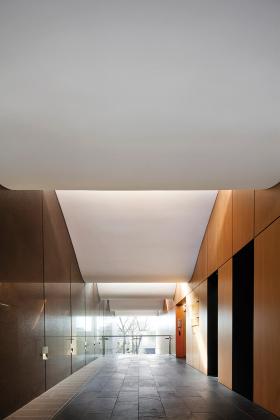Planning: Workplace health and safety: risk and opportunity in design
Libraries must be designed to ensure the health, safety and welfare of everyone who uses the building, including staff and visitors. Many people at the extremes of childhood and old age and with varying degrees of mobility will pass in and out of the building, and their safety must be considered in the planning and design of the building.
Workplace health and safety considerations

Consider these issues:
- stairs should be designed so that there are no openings between the treads or at the sides of staircases through which a small child could fall. Stair treads should be of a good depth, finished in a non-slip material and with edges well-defined visually – refer to the National Construction Code
- balcony railings must be of sufficient height to prevent a person from accidentally tipping over the top and should also consider the prevention of objects from falling – refer to the National Construction Code
- glazed features such as glass doors and large glazed areas should be fitted with markings or ‘decals’ that are clearly visible at waist height. Refer to Australian Standard 1288: Glass in buildings
- floors with highly polished surfaces should be avoided because of the danger of slipping
- mobile furniture, particularly shelving should be considered in terms of their weight before moving them – consider removing books before relocation
- staff should be properly briefed on the operation of equipment, e.g. operable walls and partitions
- potential trip hazards, such as exposed cabling, inappropriate furniture and sharp edges need to be avoided.
These issues similarly apply for staff areas with additional consideration given to:
- appropriate work areas with desk heights and chairs suitable for minimising work related injuries
- trolleys for movement of books and equipment within the library with trolleys for chair and table movement/storage if necessary
Some library staff have been proactive in ‘prototyping’ their work areas, particularly returns rooms, to ensure that it is suitable for all staff.
Reference to council’s risk assessment policy during the planning and construction stages of the library building project is recommended.
Risk and opportunity in design
The assessment and management of risks and opportunities is a key part of planning, design and building. It is related to crime prevention through environmental design (CPTED) but extends to the impact of building design on safety throughout the building’s life cycle. The earlier this process is begun, the more easily changes can be integrated into the design.
Building design must take into consideration the safety of all those involved with the building from its initial stages to its final use. Some building contractors have implemented workshops and safety spreadsheets, which are live documents updated throughout the design and construction process. This allows all team members to share their knowledge to ascertain and resolve risk issues. The relationship between building design and liability is supported by legislation, including the Environmental Planning and Assessment Act 1979.